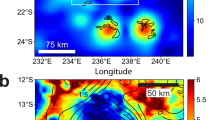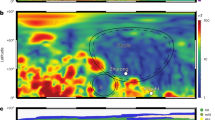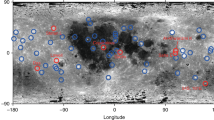Abstract
Magnetic surveys of the martian surface have revealed significantly lower magnetic field intensities over the gigantic impact craters Hellas and Argyre than over surrounding regions1. The reduced fields are commonly attributed to pressure demagnetization caused by shock waves generated during meteorite impact2,3, in the absence of a significant ambient magnetic field. Lower than average magnetic field intensities are also observed above the Vredefort meteorite crater in South Africa, yet here we show that the rocks in this crater possess much higher magnetic intensities than equivalent lithologies found elsewhere on Earth. We find that palaeomagnetic directions of these strongly magnetized rocks are randomly oriented, with vector directions changing over centimetre length scales. Moreover, the magnetite grains contributing to the magnetic remanence crystallized during impact, which directly relates the randomization and intensification to the impact event. The strong and randomly oriented magnetization vectors effectively cancel out when summed over the whole crater. Seen from high altitudes, as for martian craters, the magnetic field appears much lower than that of neighbouring terranes, implying that magnetic anomalies of meteorite craters cannot be used as evidence for the absence of the planet's internally generated magnetic field at the time of impact.
This is a preview of subscription content, access via your institution
Access options
Subscribe to this journal
Receive 51 print issues and online access
$199.00 per year
only $3.90 per issue
Buy this article
- Purchase on Springer Link
- Instant access to full article PDF
Prices may be subject to local taxes which are calculated during checkout




Similar content being viewed by others
References
Acuña, M. H. et al. Global distribution of crustal magnetization discovered by the Mars Global Surveyor MAG/ER experiment. Science 284, 790–793 (1999)
Hood, L. L., Richmond, N. C., Pierazzo, E. & Rochette, P. Distribution of crustal magnetic fields on Mars: Shock effects of basin-forming impacts. Geophys. Res. Lett. 30, 1281, doi:10.1029/2002GL016657 (2003)
Mohit, P. S. & Arkani-Hamed, J. Impact demagnetization of the Martian crust. Icarus 168, 305–317 (2004)
Moser, D. E. Dating the shock wave and thermal imprint of the giant Vredefort impact, South Africa. Geology 25, 7–10 (1997)
Stöffler, D. & Langenhorst, F. Shock metamorphism of quartz in nature and experiment: I. Basic observation and theory. Meteoritics 29, 155–181 (1994)
Grieve, R. A. F., Langenhorst, F. & Stöffler, D. Shock metamorphism of quartz in nature and experiment: II. Significance in geoscience. Meteoritics 31, 6–35 (1996)
Cloete, M. et al. Characterization of magnetite particles in shocked quartz by means of electron- and magnetic force microscopy: Vredefort, South Africa. Contrib. Mineral. Petrol. 137, 232–245 (1999)
Hart, R. J., Hargraves, R. B., Andreoli, M. A. G., Tredoux, M. & Doucouré, C. M. Magnetic anomaly near the center of the Vredefort structure: implications for impact-related magnetic signatures. Geology 23, 277–280 (1995)
Hart, R. J. et al. ‘Super magnetic’ rocks generated by shock metamorphism from the center of the Vredefort impact structure, South Africa. S. Afr. J. Geol. 103, 151–155 (2000)
Hargraves, R. B. Paleomagnetic evidence relevant to the origin of the Vredefort ring. J. Geol. 78, 253–263 (1970)
Jackson, G. M. Paleomagnetic Study and Magnetic Modeling of the Vredefort Dome. Thesis, Univ. Witwatersrand (1982)
Hargraves, R. B. & Roy, D. W. Paleomagnetism of anorthosite in and around the Charlevoix cryptoexplosion structure, Quebec. Can. J. Earth Sci. 11, 854–859 (1974)
Halls, H. C. Shock-induced remanent magnetization in late Precambrian rocks from Lake Superior. Nature 255, 692–695 (1975)
Clark, D. A. & Emerson, D. W. Notes on rock magnetic characteristics in applied geophysical studies. Exp. Geophys. 22, 547–555 (1991)
Gilder, S. & McNulty, B. Tectonic exhumation and tilting of the Mount Givens pluton, central Sierra Nevada, California. Geology 27, 919–922 (1999)
Wennerström, M. & Airo, M. L. Magnetic fabric and emplacement of the post-collisional Pomovaara Granite Complex in northern Fennoscandia. Lithos 45, 131–145 (1998)
Crawford, D. A. & Schultz, P. H. Laboratory observations of impact-generated magnetic fields. Nature 336, 50–52 (1988)
Crawford, D. A. & Schultz, P. H. Electromagnetic properties of impact-generated plasma, vapor and debris. Int. J. Impact Eng. 23, 169–180 (1999)
Turtle, E. P. & Pierazzo, E. Constraints on the size of the Vredefort impact crater from numerical modeling. Meteorit. Planet. Sci. 33, 483–490 (1998)
Gilder, S. A., LeGoff, M., Chervin, J. C. & Peyronneau, J. Magnetic properties of single and multi-domain magnetite under pressures from 0 to 6 GPa. Geophys. Res. Lett. 31, L10612, doi:10.1029/2004GL019844 (2004)
Samara, G. & Giardini, A. Effect of pressure on the Néel temperature of magnetite. Phys. Rev. 186, 577–580 (1969)
Schult, A. Effect of pressure on the Curie temperature of titanomagnetites [(1 - x)·Fe3O4–x·TiFe2O4]. Earth Planet. Sci. Lett. 10, 81–86 (1970)
Turcott, D. L. & Schubert, G. Geodynamics (Wiley & Sons, New York, 1982)
Grieve, R. A. F. & Pilkington, M. The signature of terrestrial impacts. J. Austr. Geol. Geophys. 16, 399–420 (1996)
Nel, L. T. Geological Map of the Country Around Vredefort. Scale 1:63360 (Union of S. Afr., Dept Mines and Ind., Geol. Surv., Pretoria, 1927)
Acknowledgements
We thank A. Galdeano, G. Hulot, M. Cloete, M. Le Goff, Y. Gallet and G. Plenier for discussions and comments. This work was supported by the French Ministries of Foreign Affairs and Education and Research, INSU and the South African National Research Foundation.
Author information
Authors and Affiliations
Corresponding author
Ethics declarations
Competing interests
The authors declare that they have no competing financial interests.
Rights and permissions
About this article
Cite this article
Carporzen, L., Gilder, S. & Hart, R. Palaeomagnetism of the Vredefort meteorite crater and implications for craters on Mars. Nature 435, 198–201 (2005). https://doi.org/10.1038/nature03560
Received:
Accepted:
Issue Date:
DOI: https://doi.org/10.1038/nature03560
This article is cited by
-
Ilmenite and magnetite microfabrics in shocked gneisses from the Vredefort impact structure, South Africa
Contributions to Mineralogy and Petrology (2022)
-
Plasma shielding removes prior magnetization record from impacted rocks near Santa Fe, New Mexico
Scientific Reports (2021)
-
Experimental study of morphology scaling of a projectile obliquely impacting into loose granular media
Granular Matter (2013)
-
Impact-pressure controlled orientation of shatter cone magnetizations in Sierra Madera, Texas, USA
Studia Geophysica et Geodaetica (2008)
-
Fe mineralogy of rocks from the Vredefort impact structure investigated with Mössbauer spectroscopy
Hyperfine Interactions (2008)
Comments
By submitting a comment you agree to abide by our Terms and Community Guidelines. If you find something abusive or that does not comply with our terms or guidelines please flag it as inappropriate.



